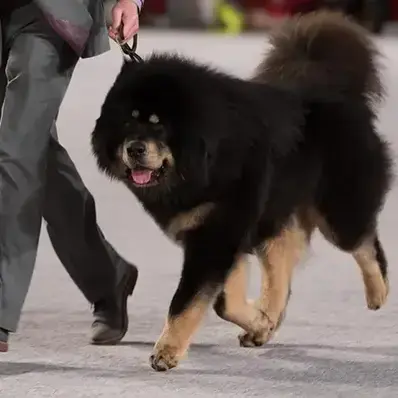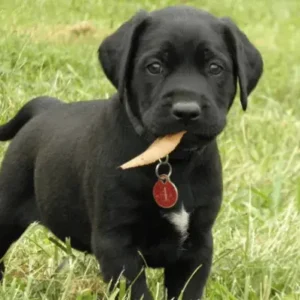Tibetan Mastiff History/Origin
The Tibetan Mastiff, originating in Tibet, has a history that traces back many centuries, although much of it is undocumented before the late 19th century. DNA evidence suggests mastiff-type dogs have been in Tibet for 5,000 years, and the Tibetan Mastiff is likely a descendant of these ancient dogs.
They evolved into two types: the Do-Khyi, who guarded flocks and traveled with nomadic shepherds, and the larger Tsang-Khyi, who served as guardians for Tibetan Buddhist monks in lamaseries.
Tibetan Mastiff in 1800- Source: AKC.org
Little was known about the breed before 1800, but Captain Samuel Turner mentioned “huge dogs” in his 1800 memoir. The first Tibetan Mastiff imported to England in 1847 was a gift to Queen Victoria from Lord Hardinge. The breed was officially recognized by England’s Kennel Club in 1873.
The Prince of Wales, later King Edward VII, imported two more Tibetan Mastiffs in 1874. The first breed club was established in 1931, but World War II halted breeding efforts. English breeders resumed importing Tibetan Mastiffs in 1976.
In the United States, two Tibetan Mastiffs were given to the President in the late 1950s but disappeared from public view. More Tibetan Mastiffs were imported in the 1970s, forming the foundation of the American line. The Tibetan Mastiff Club of America and the American Tibetan Mastiff Association were founded in 1974, and the breed first appeared in a show in 1979.
The American Kennel Club recognized the Tibetan Mastiff as part of the Working Group in January 2007. Today, purebred Tibetan Mastiffs are rare in Tibet but can still be found guarding livestock and homes.
Tibetan Mastiff in Katmandu, 1966- Source: AKC.org
Tibetan Mastiff Personality
The word “challenging” is frequently applied to this independent, stubborn breed. The Tibetan Mastiff is one of the dog breeds that is intelligent and has a strong sense of self, expecting to be treated equally, not as a pet. While he wants to please his people, he also has his agenda and must often be reminded of what he’s been asked to do.
- Temperament
The Tibetan Mastiff is known for its independent strong-willed temperament. They are aloof with strangers but deeply loyal and protective of their family and territory.
This breed is typically calm and composed, yet they can be wary of unfamiliar situations or people. Tibetan Mastiffs require early socialization and consistent, firm training to appropriately channel their natural guarding instincts.
- Potential Challenges
Owning a Tibetan Mastiff can present several challenges, primarily due to their strong-willed and independent nature. They require an experienced owner who can provide firm and consistent training, as they may be stubborn and resistant to commands.
Their protective instincts can lead to aggressive behavior towards strangers and other animals if not properly socialized. Additionally, their size and strength make them difficult to manage without adequate training and control, posing a potential challenge for inexperienced owners.
Tibetan Mastiff Physical Appearance
The breed is large and athletic, giving off a solemn but alert appearance. It stands well on its pasterns and has tight cat-like feet. This giant’s body is slightly longer than it is tall. It has a broad and impressive head, with deep-set, almond-shaped, brown eyes. The muzzle is broad and squared, and this strong pup looks watchful. Its tail is well-feathered, densely coated, and curls over the back.
- Size
The Tibetan Mastiff stands between 24 to 26 inches tall. It typically weighs between 75 and 160 pounds. This substantial size contributes to its imposing and powerful presence.
- Coat color
The Tibetan Mastiff has a double coat consisting of a long, thick, coarse topcoat and a dense, soft undercoat. During warmer months, the undercoat thins out. The hair is straight and hard, never curly, wavy, or silky. The neck and shoulders are covered with a heavy mane, and the tail and upper thighs (breeches) have dense coats and feathers. Males generally have more coats than females, including a thicker mane.
Coat colors include black, brown, gold, and blue, with or without tan markings above and around the eyes. Some Tibetan Mastiffs may have small white markings on the chest and feet but nowhere else on the body. The undercoat may be lighter shades of the main color, or gray or tan on black and tan dogs.
Gold Tibetan Mastiff- Source: tibetan_mastiffs_uk
Red Tibetan Mastiff- Source: tibetan_mastiff_nd_gaddi_dogs
Brown Tibetan Mastiff- Source: ask_the_tibetan_mastiff
Tibetan Mastiff Gender Differences
Male Tibetan Mastiffs typically stand at least 26 inches tall at the shoulder and weigh between 100 to over 160 pounds. Females are generally at least 24 inches tall at the shoulder and weigh between 75 to over 125 pounds. Despite their size differences, both genders share a similar temperament, characterized by their protective nature and aloofness towards strangers.
Tibetan Mastiff Feed/Nutrition
Feed your adult Tibetan Mastiff 4 to 6 cups or more of high-quality dog food daily, split into two meals. After vigorous exercise, wait at least an hour before offering food or water to prevent gastric dilatation volvulus (bloat).
The amount your dog eats depends on factors like size, age, metabolism, and activity level. Just like people, dogs have individual needs; active dogs require more food than less active ones.
The quality of dog food impacts how nourishing it is; better-quality food means you’ll need less to satisfy your dog’s nutritional needs. Tomatoes can be a healthy snack in moderation, but remove the stems and leaves as they can be toxic.
Tibetan Mastiff Health
Tibetan Mastiffs are generally healthy, yet like all breeds, they can be prone to certain health issues. Not every TM will develop all of these conditions, but it’s crucial to understand them if you’re considering this breed.
- Hip Dysplasia: CHD is a heritable condition where the thighbone doesn’t fit properly into the hip joint, leading to lameness or arthritis. Screening for CHD is typically conducted via X-rays by organizations like the Orthopedic Foundation for Animals or PennHIP. Dogs with hip dysplasia should not be used for breeding. While hereditary, CHD can be exacerbated by environmental factors such as rapid growth or injuries.
- Elbow Dysplasia: It is another heritable condition common in large breeds, resulting from different growth rates of the elbow bones, causing joint laxity and painful lameness. Treatment options may include surgery, weight management, or medication, depending on severity.
- Panosteitis: Often termed canine growing pains, affects young, large-breed dogs by inflaming long bones, causing shifting lameness that usually resolves with maturity. Pain can be managed with medication during this time.
- Osteochondritis Dissecans: OCD is an orthopedic condition caused by improper cartilage growth in joints, typically appearing in shoulders but also elbows. Early detection, usually around five to seven months of age, may require surgical intervention, and affected dogs should not be bred.
- Canine Inherited Demyelinative Neuropathy: CIDN manifests in Tibetan Mastiff puppies by six weeks of age, affecting the nervous system and leading to progressive weakness and paralysis. Although incurable, selective breeding practices have reduced its occurrence.
- Hypothyroidism: An endocrine disorder affecting older dogs, results from thyroid hormone deficiency and presents with symptoms like weight gain and lethargy. Management involves lifelong medication once diagnosed.
When purchasing a puppy, ensure the breeder provides health clearances for both parents, confirming they’ve been tested and cleared of specific conditions. This ensures you’re choosing a healthier foundation for your Tibetan Mastiff.
Tibetan Mastiff Care and Grooming
The Tibetan Mastiff sheds minimally, with seasonal shedding depending on the climate. Brush with a wire slicker brush one to three times weekly to remove loose hair and prevent tangles, especially in dense areas like the mane, breeches, and tail.
Bathe as needed, typically once a month, due to their low odor. For dental care, brush teeth two to three times weekly, ideally daily.
Trim nails every one to two months or when you hear them clicking on the floor. Regular nail trimming prevents snagging and keeps feet healthy. Check ears weekly for debris or irritation, and clean as needed with a vet-recommended cleanser and cotton ball.
Tibetan Mastiffs have moderate exercise needs. They require daily walks and enjoy playtime in a secure yard. While they don’t demand intense exercise, they benefit from activities that engage both their body and mind.
A combination of physical activity and mental challenges will help keep your Tibetan Mastiff healthy and content. Consistent training, such as teaching your dog not to bite, helps promote good behavior and enhances their well-being.
Tibetan Mastiff Rescue Groups
Rescuing a Tibetan Mastiff can be a rewarding experience, offering a loving home to a dog in need. Tibetan Mastiff rescues often have adults and sometimes puppies available for adoption, providing an opportunity to give these majestic dogs a second chance. By adopting from a rescue organization, you not only enrich your own life but also contribute to the welfare and future of the breed.
Tibetan Mastiff Price
The price of a Tibetan Mastiff typically ranges from $2,000 to $6,000, depending on factors such as breeder reputation, pedigree, and location.
When considering purchasing a Tibetan Mastiff, it’s essential to seek reputable breeders who prioritize health and temperament. Responsible breeders provide health clearances and socialization for their puppies, ensuring they’re well-prepared for their new homes.
Interesting Facts
- The Tibetan Mastiff’s mane of fur around its head and shoulders gives it a resemblance to a lion.
Rock Dog – Source: IMDb
- They have appeared in an animated movie “Rock Dog”.
- They have been featured in the Breed Judging Show 2023.
Best For
Tibetan Mastiffs are best for experienced owners who understand large, independent breeds. They excel as guard dogs and require firm, gentle handling and consistent training. They thrive in homes with space to exercise and early socialization.
Top Names
| Male Tibetan Mastiff Names | Female Tibetan Mastiff Names |
| Thor | Luna |
| Zeus | Bella |
| Bear | Athena |
| Leo | Nala |
| Titan | Sasha |









 Tibetan Mastiff in 1800- Source:
Tibetan Mastiff in 1800- Source:  Tibetan Mastiff in Katmandu, 1966- Source:
Tibetan Mastiff in Katmandu, 1966- Source: 

 Gold Tibetan Mastiff- Source:
Gold Tibetan Mastiff- Source:  Red Tibetan Mastiff- Source:
Red Tibetan Mastiff- Source:  Brown Tibetan Mastiff- Source:
Brown Tibetan Mastiff- Source: 
 Rock Dog – Source:
Rock Dog – Source: 






